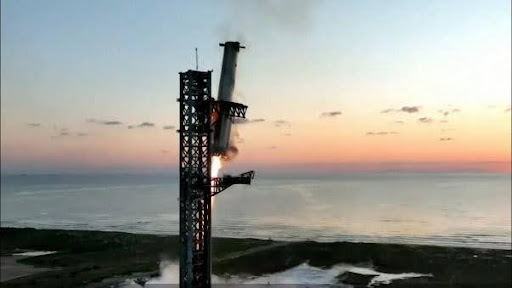Article 3:Agent-Based AI: A Decentralized Approach to PNT
Last Updated: 24/10/2024 08:46 Created at: 24/10/2024 07:28
Recent advancements in aerospace technology have demonstrated remarkable precision in complex operations. Recently, SpaceX achieved a significant milestone when its "Mechazilla" launch-tower cradle successfully caught the returning SpaceX's Super Heavy booster after a Starship test launch. While the exact mechanisms behind this feat are not publicly disclosed, it exemplifies the kind of challenge that agent-based artificial intelligence (AI) could potentially address. For instance, such a system might involve multiple AI agents working in concert - the booster's navigation system continuously adjusting its trajectory, the tower's positioning mechanism adapting to real-time data, and a central coordination agent optimizing the overall operation. This article explores how similar agent-based AI approaches could revolutionize positioning, navigation, and timing (PNT) networks in aerospace applications. We examine recent research and discuss potential implementations to enhance the robustness, adaptability, and efficiency of these critical systems in increasingly complex operational environments.
This is the third and final article of a series dedicated to the potential Artificial Intelligence contribution to the development of Positioning, Navigation and Timing products and services.
You can also have a look at the first and second article.
 Agent-based artificial intelligence (AI) offers a promising solution. This subfield of AI focuses on developing autonomous systems—called agents—that independently perceive, process, and act within their environment to achieve predefined goals. Unlike traditional centralized AI systems, agent-based AI is decentralized, with agents operating collaboratively to enhance system robustness. In the context of PNT, these agents could be satellites,
Agent-based artificial intelligence (AI) offers a promising solution. This subfield of AI focuses on developing autonomous systems—called agents—that independently perceive, process, and act within their environment to achieve predefined goals. Unlike traditional centralized AI systems, agent-based AI is decentralized, with agents operating collaboratively to enhance system robustness. In the context of PNT, these agents could be satellites,
ground stations, or user devices, all working together to create resilient, adaptive networks.
Recent research on the topic reveals that the use of Multi-Agent Reinforcement Learning (MARL) many advantages for distributed cooperative vehicular positioning, demonstrating the potential of combining traditional Bayesian filtering techniques with AI-driven optimisation to improve vehicle-to-everything (V2X) communication and overall system efficiency in complex environments. Their method is leveraging a Decentralized Partially Observable Markov Decision Process (Dec-POMDP) framework to enhance positioning accuracy through implicit cooperative positioning and message passing algorithms.

Rather than replacing core PNT infrastructure, agent-based AI has the potential to significantly enhance the robustness of the systems that support navigation and flight operations.
These intelligent systems could enable decentralized flight planning independent of cloud-based services, local real- time weather integration and analysis, adaptive air traffic management systems that function autonomously when needed, and distributed data storage and processing to ensure critical information remains accessible. For instance, a recent study on large-scale indoor 3D reconstruction with multiple robots demonstrated a framework that addresses localization, coordination, and vision processing using a combination of visible light positioning, multi-agent reinforcement learning for pathfinding, and 360° camera techniques for 3D modelling. The study showcases how AI-driven agents can collaborate to perform centimetre-level localization and efficient 3D reconstruction without reliance on additional infrastructure. This capability could be extended to aerospace environments, offering a vision of decentralized, resilient, and self-sustaining navigation networks. Agent-based AI has the potential to revolutionize navigation and positioning systems (PNT) by enabling decentralized decision-making, enhancing robustness, and adapting to complex environments. It aligns with the Connected, Cooperative Automated Mobility (CCAM) paradigm, where vehicles and infrastructure communicate for improved safety, efficiency, and sustainability. In PNT systems, agent-based AI can seamlessly integrate autonomous platforms like unmanned aerial vehicles and self-driving cars into cohesive networks, optimizing traffic flow and enabling advanced applications like Vehicle-to-Everything (V2X) communication. NAVISP’s upcoming call for proposals (EL1) offers exciting opportunities to contribute to groundbreaking projects, such as the EL1-095 Exploitation of Geo-Spatial Data for Automated Vehicles, focus is on leveraging geo-spatial datasets—such as Digital Elevation Models (DEMs) and 3D Building Models (3DBMs)—to enhance positioning accuracy in urban environments. This project aims to improve GNSS-based navigation for Connected, Cooperative, and Automated Vehicles (CCAV) through the efficient use of geo-spatial data. If you're intrigued by the potential of cutting-edge navigation systems, explore our website for EL1 Workplan and open opportunities. Your expertise could be instrumental in shaping the future of positioning technology. To support CCAM development, we launched a thematic window soliciting proposals for PNT applications in this area, building upon previous efforts and aligning with broader industry trends. Keep an eye on our website for future thematic windows and upcoming opportunities to contribute to shaping the future of navigation and positioning technology.
